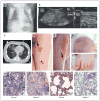Integrin α3 mutations with kidney, lung, and skin disease
- PMID: 22512483
- PMCID: PMC3341404
- DOI: 10.1056/NEJMoa1110813
Integrin α3 mutations with kidney, lung, and skin disease
Abstract
Integrin α(3) is a transmembrane integrin receptor subunit that mediates signals between the cells and their microenvironment. We identified three patients with homozygous mutations in the integrin α(3) gene that were associated with disrupted basement-membrane structures and compromised barrier functions in kidney, lung, and skin. The patients had a multiorgan disorder that included congenital nephrotic syndrome, interstitial lung disease, and epidermolysis bullosa. The renal and respiratory features predominated, and the lung involvement accounted for the lethal course of the disease. Although skin fragility was mild, it provided clues to the diagnosis.
Figures


References
-
- Danen EH, Sonnenberg A. Integrins in regulation of tissue development and function. J Pathol. 2003;200:471–80. [Corrected and republished, J Pathol 2003;201: 632–41.] - PubMed
-
- Kambham N, Tanji N, Seigle RL, et al. Congenital focal segmental glomerulosclerosis associated with beta4 integrin mutation and epidermolysis bullosa. Am J Kidney Dis. 2000;36:190–6. - PubMed
-
- Margadant C, Charafeddine RA, Sonnenberg A. Unique and redundant functions of integrins in the epidermis. FASEB J. 2010;24:4133–52. - PubMed
Publication types
MeSH terms
Substances
Grants and funding
LinkOut - more resources
Full Text Sources
Other Literature Sources
Medical
Molecular Biology Databases
